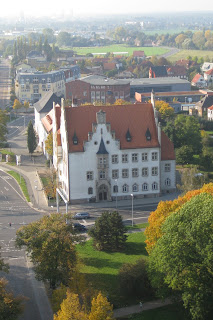
 Well, time to think about packing up and going home. What a piece of luck to have had the chance to settle down in Berlin for four months. Of the many good things that I'll miss, here are photos of two. The first is "Paulchen" (little Paul, literally, though not so little at all ), definitely the ugliest and probably the most beloved dog in our neighborhood. He goes for an hour-long walk every morning with his keeper, someone who loves to talk to him. Actually it's a love-hate relationship. He gets scolded a lot.
Well, time to think about packing up and going home. What a piece of luck to have had the chance to settle down in Berlin for four months. Of the many good things that I'll miss, here are photos of two. The first is "Paulchen" (little Paul, literally, though not so little at all ), definitely the ugliest and probably the most beloved dog in our neighborhood. He goes for an hour-long walk every morning with his keeper, someone who loves to talk to him. Actually it's a love-hate relationship. He gets scolded a lot. The second is my line dancing class at the 'Seniorenclub in der Herthastrasse'. Maybe you can tell from the picture that we bonded pretty well. Lots of fun on Monday and Tuesday afternoons and a great bunch of people, and I'm missing them already.















































